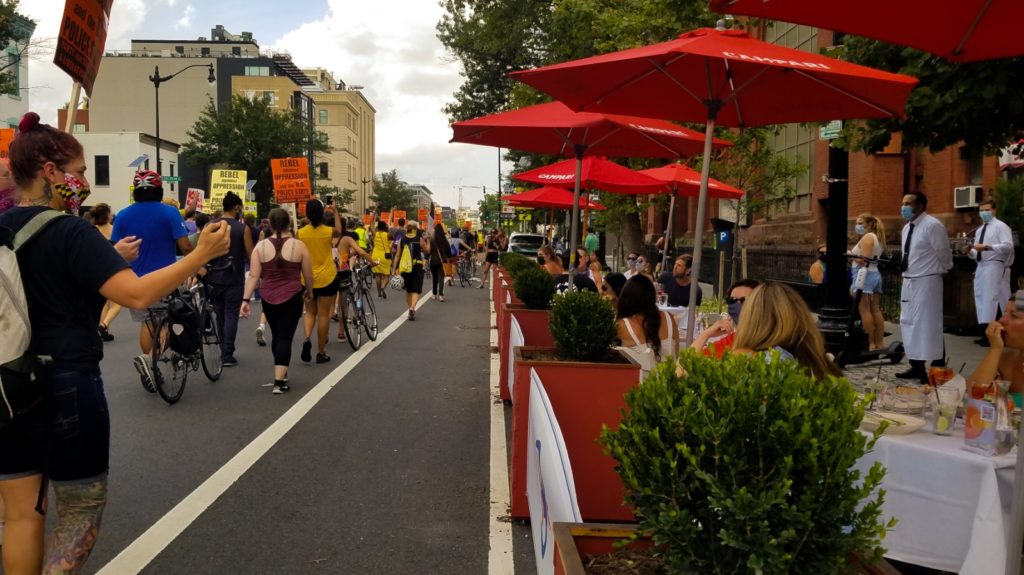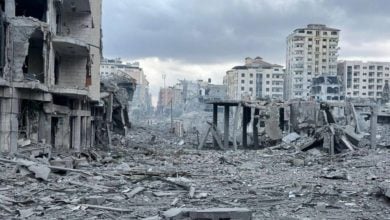People from across the Washington, D.C. metro area converged outside of the White House on Saturday, July 25, to protest in solidarity with anti-racist protesters in Portland, Oregon, who are being targeted with exceptional violence from federal police sent by U.S. President Donald Trump to crush what have been nearly two months of continuous demonstrations.
“Converged on the White House” is something of a misnomer, though, since the size and militancy of protests in Washington, D.C., have seen the Trump administration erect barrier after barrier in an effort to distance the ruling class’s chief executive from working and oppressed people demanding change. Huge fences bolted together deny protesters the traditionally free protest space of Pennsylvania Avenue and Lafayette Park, from which protesters were violently evicted on June 1.
As a consequence, the Party for Socialism and Liberation, in conjunction with other groups including Code Pink, Popular Resistance, the ANSWER Coalition, Stop Police Terror Project D.C., and Freedom Fighters D.C., pushed their rally from the sidewalks onto H Street, shutting down traffic next to Black Lives Matter Plaza.
“When we see these federal officers in the streets of Portland, we are standing on the precipice of an alt-right fascist assault that’s trying to crush this movement,” Sean Blackmon of the PSL’s D.C. branch said. “And they’ve already been trying to do it. If you were here in D.C., then you saw that the more the police tried to crush the protests, the more people came out. Day by day, the people were defiant against that violence. That didn’t work.”
Leonardo Flores of Code Pink highlighted how racism at home and imperialism abroad are connected, noting that Customs and Border Protection’s BORTAC tactical units train at the Western Hemisphere Institute for Security Cooperation, formerly known as the U.S. Army School of the Americas.
“The worst of the worst of Latin America’s police and military forces” trained at WHINSEC, which is located at Fort Benning, Georgia, Flores said, “to teach these authoritarian forces how to torture folks, and that’s where CBP is training. And now they’re deployed to Portland and Trump has threatened to deploy them elsewhere. The violence abroad is now coming home and they’re intimately connected … war and racism are institutions that reinforce each other and you can’t fight one without fighting the other.”
“There is a level of importance to this movement that I don’t think we’ve seen in a very long time,” Gail Tolbersmith from the PSL’s D.C. branch said. “From the beginning, we have seen a terseness and a very rich anger towards the levels of police brutality that has plagued our communities for decades. And now we have seen the attempts to crush it, be it in Portland, be it in D.C., all around the country – between the apparent co-option versus violent repression, we have seen how the attempts to control and destroy this movement have operated. And we haven’t seen it work,” she said, noting that with it has come an increasing awareness of the true scope of capitalist violence, which includes surveillance and evictions in communities.
One protester who wished to remain anonymous came with a group of yellow-clad mothers who called themselves the D.C. detachment of the Wall of Moms, a phenomenon seen in the Portland protests that featured mothers linking arms in the face of advancing police lines in a bid to stem their violent response to the protests.
“I’m both a mom and a protester, so this has special meaning for me,” she told Liberation News. She noted that while it is good that more mothers are coming out in protest, “we have to recognize that moms have always been on the front lines protesting.”
Carol Coakley told Liberation News she had traveled from Charleston, South Carolina, to take part in Saturday’s protest outside the White House. “I knew I had to be here,” she said- urging that whether it’s against food deserts or racist police terror, it’s important to keep fighting.
By then roughly 200-strong, the crowd took its militant message to the streets of Washington, D.C., chanting, “Protect and serve, that’s a lie, you don’t care if people die” and “These racist cops have got to go!”
The protesters marched up 14th Street and down U Street, two neighborhoods that were once cornerstones of the Black community in D.C.. Their intersection was “ground zero” for the uprising that rocked the city in April 1968, after Dr. Martin Luther King, Jr. was assassinated, and much of the area burned in the ensuing conflagration. Today, the neighborhoods are being increasingly gentrified, and the protesters chanted, “Black people used to live here,” and “Out of the bars and into the streets,” as they marched past block after block of brunchers on cafes’ outdoor patios.
Everywhere the march went, it received cries, whistles and honks of support from sidewalks, apartment building windows, and drivers passing by. Service staff at restaurants came out and cheered and passers-by joined in the march. Water and snacks were provided for the marchers by a local mutual aid group who told Liberation News they had previously set up a tent on Black Lives Matter Plaza to offer its services, only to be evicted by the police on spurious grounds.
As the march ended at the African-American Civil War Memorial, where a bronze statue depicts the Black men who picked up the rifle to fight for the abolition of Black enslavement, the protesters mutually pledged not to let the movement die and to remain in the streets.






